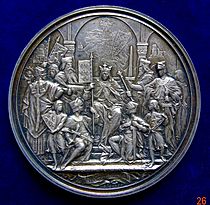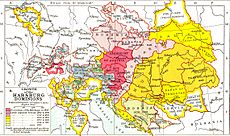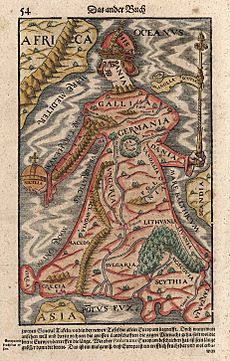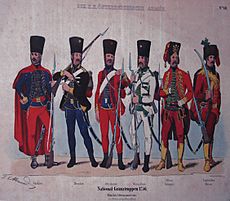Habsburg monarchy facts for kids
Quick facts for kids
Habsburg monarchy
Habsburgermonarchie
|
|
|---|---|
| 1282–1918 | |
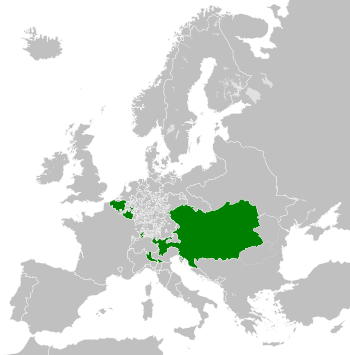
The Habsburg monarchy in 1789
|
|
| Status | Part of the Holy Roman Empire (partly) Personal union |
| Capital | |
| Main languages | Latin, German, Hungarian, Czech, Croatian, Romanian, Istro-Romanian, Slovak, Slovene, Dutch, Lombard, Venetian, Friulian, Ladin, Italian, Polish, Ruthenian, Serbian, French, Yiddish |
| Religion | Majority: Roman Catholic (official) Minorities: Reformed, Lutheran, Eastern Orthodox, Utraquist, Jewish, Abrahamite |
| Government | Feudal monarchy |
| Monarch | |
|
• 1282–1308
|
Albert I of Germany and Rudolph II of Austria |
|
• 1916–1918
|
Charles I of Austria-Hungary |
| State Chancellor | |
|
• 1753–1793
|
Wenzel Anton |
| Historical era | Early modern/Napoleonic |
|
• Diet of Augsburg assigns Duchy of Austria to the Habsburgs.
|
December 1282 |
|
• Duchy of Austria elevated to Archduchy of Austria
|
1358 |
|
• Marriage of Philip of Austria, Lord of the Netherlands to Joanna of Aragon
|
20 October 1496 |
| 14 July 1683 | |
| 1740–1748 | |
|
• Austro–Turkish War
|
1787–1791 |
|
• Treaty of Sistova
|
4 August 1791 |
|
• Austrian Empire declared
|
11 August 1804 |
| 29 May 1867 | |
|
• Aster Revolution
|
31 October 1918 |
|
Main religion of the Czech people, in the Kingdom of Bohemia recognized until 1627 when it was forbidden.
German replaced Latin as the official language of the Empire in 1784. |
|
The Habsburg monarchy was a huge collection of lands and kingdoms. They were all ruled by the powerful Habsburg family, especially the Austrian part of the family. People often called it "Austria" for short.
From 1438 to 1806, a member of the Habsburg family was usually the Holy Roman Emperor. But the Habsburg monarchy was different from the Holy Roman Empire itself. The Holy Roman Empire had many states ruled by their own families, and the emperor had limited power over them.
The story of the Habsburg monarchy began in 1273. That's when Rudolf I became King of Germany. In 1282, he gained control of the Duchy of Austria for his family. Later, in 1482, Maximilian I added the Netherlands to the family's lands through marriage.
These new lands were passed down to his grandson, Charles V. Charles V also inherited Spain and its colonies. This made the Habsburg empire the biggest it had ever been!
In 1556, Charles V decided to step down. He split his vast empire into two main parts. His brother, Ferdinand I, got the Austrian lands. He also became king of Hungary and Bohemia. Charles V's son, Philip II of Spain, received Spain and its colonies.
The Spanish part of the family eventually died out in 1700. The Austrian part of the family continued to rule. They held the imperial throne and controlled Hungary and Bohemia.
The Habsburg monarchy wasn't one single country with one set of laws. It was a collection of different kingdoms and lands. These lands were only united because the same person was their ruler. This type of "composite state" was common in Europe during the early modern period.
In the early 1800s, the Habsburg lands were formally united. In 1804, they became the Austrian Empire. Later, in 1867, it became the Austro-Hungarian Empire. This empire lasted until 1918, when it fell apart after World War I.
The capital city of the Habsburg monarchy was Vienna. However, for a short time (from 1583 to 1611), the capital was in Prague.
Contents
How the Habsburg Monarchy Began and Grew
The Habsburg family started in the late 900s. Their family name came from Habsburg Castle in what is now Switzerland.
In 1279, the Habsburgs began to rule the Duchy of Austria. This duchy was part of the Holy Roman Empire. In 1282, King Rudolf I of Germany gave the Duchy of Austria to his sons. This created the "Austrian hereditary lands" for the Habsburg family. From then on, the Habsburgs were also known as the House of Austria.
Between 1438 and 1806, most of the time, a Habsburg ruler was chosen to be the Holy Roman Emperor.
Growing Through Marriages
The Habsburgs became very powerful in Europe thanks to smart marriages. Maximilian I, Holy Roman Emperor married Mary of Burgundy. This brought the rich Burgundian Netherlands into the Habsburg family.
Their son, Philip the Handsome, married Joanna the Mad of Spain. She was the daughter of the famous Spanish rulers, Ferdinand II of Aragon and Isabella of Castile.
Charles V, Holy Roman Emperor, who was the son of Philip and Joanna, inherited many lands:
- The Habsburg Netherlands in 1506.
- Habsburg Spain and its territories in 1516.
- Habsburg Austria in 1519.
Charles V's empire was so big that he had to travel constantly. He needed people to help him govern his many lands. For example, his brother Ferdinand I, Holy Roman Emperor became the ruler of the Austrian lands in 1521.
Bohemia and Hungary Join the Lands
In 1526, King Louis II of Hungary died fighting the Ottoman Turks. Archduke Ferdinand, who was Louis's brother-in-law, was then chosen as the King of Bohemia and Hungary.
Bohemia and Hungary became permanent Habsburg lands later on. After winning a battle against Bohemian rebels in 1620, Ferdinand II made sure Bohemia would always be ruled by the Habsburgs. Later, after a big victory against the Ottoman Turks in 1687, Leopold I made Hungary a hereditary kingdom for the Habsburgs too.
In 1556, Charles V divided the Habsburg family into two main branches. He gave Austria and the Imperial crown to Ferdinand. He gave the Spanish empire to his son, Philip II of Spain. The Spanish branch ended in 1700. The Austrian branch continued to rule the Holy Roman Empire, Hungary, and Bohemia.
Names for the Habsburg Monarchy
The Habsburg monarchy had many different names over time:
- Habsburg monarchy: This was a common, unofficial name.
- Austrian monarchy: This name became popular around 1700.
- Danubian monarchy: Another unofficial name, often used at the time.
- Dual monarchy: This referred to the two main parts: the Duchy of Austria and the Kingdom of Hungary, both under one ruler.
- Austrian Empire: This was the official name from 1804, after the Holy Roman Empire ended.
- Austria-Hungary: This name was used from 1867 to 1918. The official name was Austro-Hungarian Monarchy.
- Crownlands: This term was used for all the individual parts of the Austrian Empire from 1849. After 1867, Hungary was no longer called a "crownland."
- The Hungarian parts were called "Lands of the Crown of Saint Stephen."
- The Bohemian (Czech) lands were called "Lands of the St. Wenceslaus' Crown."
Important Territories of the Monarchy
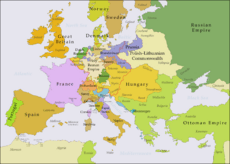
The lands ruled by the Habsburgs changed over time. But four main groups of territories were always at its core:
- The Hereditary Lands: These were the original Habsburg territories. They included most of modern Austria and Slovenia. They also had parts of northeastern Italy and southwestern Germany.
- Archduchy of Austria (Upper and Lower Austria)
- Inner Austria (Styria, Carinthia, Carniola, Trieste, Istria, Gorizia and Gradisca)
- County of Tyrol
- Further Austria (Vorarlberg and the Vorlande)
- Grand Duchy of Salzburg (after 1805)
- The Lands of the Bohemian Crown: These lands elected Ferdinand as their king in 1526.
- Kingdom of Bohemia
- Margraviate of Moravia
- Silesia (most of it was lost to Prussia in the 1740s)
- Lusatia (ceded to Saxony in 1635)
- The Kingdom of Hungary: A large part of medieval Hungary was taken by the Ottoman Empire. The Habsburgs ruled the western and northern parts. In 1699, after wars with the Ottomans, more of Hungary came under Habsburg rule.
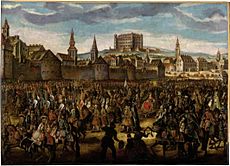
- Kingdom of Croatia
Other Lands Ruled by Habsburgs
Over the centuries, other lands were also ruled by the Austrian Habsburgs. Sometimes, different branches of the family ruled these areas.
- Kingdom of Slavonia (1699–1868)
- Grand Principality of Transylvania (1699–1867)
- Austrian Netherlands (most of modern Belgium and Luxembourg) (1713–1792)
- Duchy of Milan (1713–1797)
- Kingdom of Naples (1713–1735)
- Kingdom of Sardinia (1713–1720)
- Kingdom of Serbia (1718–1739)
- Kingdom of Sicily (1720–1735)
- Duchy of Parma (1735–1748)
- Kingdom of Galicia and Lodomeria (in modern Poland and Ukraine) (1772–1918)
- Duchy of Bukovina (1774–1918)
- New Galicia (Polish lands, including Kraków) (1795–1809)
- Venetia (1797–1805)
- Kingdom of Dalmatia (1797–1805, 1814–1918)
- Kingdom of Lombardy–Venetia (1814–1866)
- Kraków (incorporated into Galicia) (1846–1918)
- Voivodeship of Serbia and Banat of Temeschwar (1849–1860)
- Kingdom of Croatia-Slavonia (1868–1918)
- Bosnia and Herzegovina (occupied 1878, annexed 1908–1918)
The Habsburgs also held the title of Holy Roman Emperor for most of the time between 1438 and 1806.
How the Monarchy Was Governed
In the early days, each part of the Habsburg monarchy was governed by its own rules and traditions. Not all provinces were even ruled by the same person. Younger family members sometimes ruled parts of the hereditary lands.
Serious efforts to centralize power began in the mid-1700s. This happened under Maria Theresa and especially her son Joseph II. Joseph II tried many big reforms, but many were stopped because people resisted them.
Another attempt to centralize power happened after the revolutions of 1848. For the first time, ministers tried to make the monarchy a single, unified state ruled from Vienna. Hungary was put under military rule. However, after losing wars in 1859 and 1866, these policies were slowly given up.
The Austro-Hungarian Compromise of 1867
In 1867, a famous agreement called the Austro-Hungarian Compromise of 1867 was made. This created the "dual monarchy" of Austria-Hungary. In this system, the Kingdom of Hungary was an equal partner. It was connected to the other Habsburg lands only by having the same ruler and a shared foreign and military policy.
The non-Hungarian Habsburg lands were called "Austria." They had their own parliament and government. When Bosnia and Herzegovina was annexed, it was not part of either Austria or Hungary. It was governed by a shared ministry.
The Habsburg monarchy finally fell apart at the end of World War I. Many different ethnic groups wanted their own independent countries. After its collapse, new countries were formed. These included Austria, the First Hungarian Republic, Poland, Yugoslavia, and Czechoslovakia. Some territories also went to Romania and Italy.
Other Habsburg Rulers
Some junior lines of the Habsburg family ruled other areas:
- The Grand Duchy of Tuscany (1765–1801, and 1814–1859).
- The Duchy of Modena (1814–1859).
- Empress Marie Louise, Napoleon's second wife and daughter of the Austrian Emperor, ruled the Duchy of Parma (1814–1847).
- Maximilian I of Mexico, brother of Emperor Franz Josef, was Emperor of the Second Mexican Empire (1863–1867).
Habsburg Rulers (1508–1918)
The Habsburg monarchs held many different titles. They ruled each kingdom with a different name and position.
- Frederick III (1452–1493)
- Maximilian I (1493–1519)
- Charles V (1519–1556)
- Ferdinand I (1556–1564)
- Maximilian II (1564–1576)
- Rudolf II (1576–1612)
- Matthias (1612–1619)
- Ferdinand II (1619–1637)
- Ferdinand III (1637–1657)
- Leopold I (1657–1705)
- Joseph I (1705–1711)
- Charles VI (1711–1740)
- Maria Theresa (1740–1780)
Habsburg-Lorraine Rulers
- Joseph II (1780–1790), known as "the great Reformer"
- Leopold II (1790–1792)
- Francis II (1792–1835), became Emperor Francis I of Austria in 1804
- Ferdinand I (1835–1848), known as "Ferdinand the Good"
- Francis Joseph I (1848–1916), brother of Emperor Maximilian I of Mexico
- Charles I (1916–1918), the last reigning monarch of Austria-Hungary
See also
 In Spanish: Imperio Habsburgo para niños
In Spanish: Imperio Habsburgo para niños





